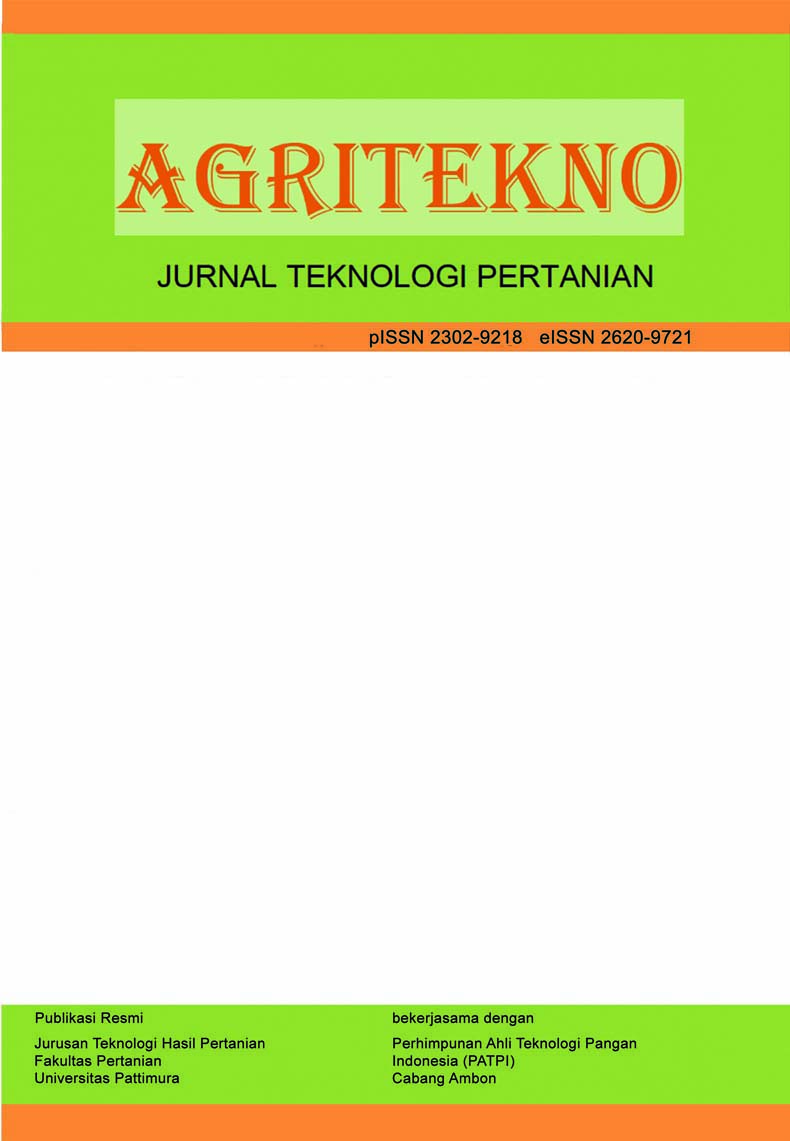Karakteristik Kimia dan Sensori Fruit Leather Buah Kuini dan Umbi Bit
Chemical and Sensory Properties of Kuini Fruit and Beetroot Fruit Leather
Abstract
Chemical and sensory properties of kuini fruit and beetroot was studied by using Completely Randomized Design with five treatments and three replications. The treatments were kuini fruit and beetroot pulp combination, namely KB1 (90:10), KB2 (80:20), KB3 (70:30), KB4 (60:40), and KB5 (50:50). Moisture content, ash content, pH, crude fiber content, total sugar content, antioxidant activity, and sensory assessment (descriptive and hedonic) were observed on the fruit leather. The data obtained were analyzed statistically by using Anova and DNMRT at a α 0.05 level. The results showed that the combination of kuini fruit and beetroot in the fruit leather had a significant effect on moisture content, ash content, pH, crude fiber content, total sugar content, and sensory assessment of the fruit leather. The best treatment in this research was KB2 with characteristics of 9.75% moisture content, 0.84% ash content, 3.46 pH, 4.16% crude fiber content, 63.73% total sugar content, and 181.32 ppm IC50. The best treatment of fruit leather was dark red color, very flavorful kuini fruit, very sweet, and chewy texture that was preferred by panelists for an overall assessment.
Downloads
References
Aguiar, J., Gonçalves, J. L., Alves, V. L., & Câmara, J. S. (2021). Relationship between volatile composition and bioactive potential of vegetables and fruits of regular consumption—An integrative approach. Molecules, 26(12). https://doi.org/10.3390/molecules26123653
Almuslet, N. A., Hassan, E. A., Al-Sherbini, A. S. A. E. M., & Muhgoub, M. G. A. (2012). Diode laser (532 nm) induced grafting of polyacrylamide onto Gum Arabic. Journal of Physical Science, 23(2).
Asra, R., Yetti, R. D., Ratnasari, D., & Nessa, N. (2020). Studi fisikokimia betasianin dan aktivitas antioksidan dari umbi bit merah (Beta vulgaris L.). Journal of Pharmaceutical and Sciences, 3(1), 14–21. https://doi.org/10.36490/journal-jps.com.v3i1.35
Chng, Y. V. G., Chang, L. S., & Pui, L. P. (2020). Effects of maltodextrin concentration and inlet temperature on the physicochemical properties of spray-dried kuini powder. Asia-Pacific Journal of Molecular Biology and Biotechnology, 28(4), 117–131. https://doi.org/10.35118/apjmbb.2020.028.4.10
Diamante, L. M., Bai, X., & Busch, J. (2014). Fruit Leathers: Method of preparation and effect of different conditions on qualities. International Journal of Food Science, 2014. https://doi.org/10.1155/2014/139890
Fachriah, K., & Rahmawati, R. (2022). Physicochemical and sensory characteristic of starfruit-red guava fruit leather as affected by the addition of arabic gum. Jurnal Teknologi, 84(1), 11–19. https://doi.org/10.11113/jurnalteknologi.v84.16642
Ferdiawan, N., Nurwantoro, & Dwiloka, B. (2019). Pengaruh lama waktu germinasi terhadap sifat fisik dan sifat kimia tepung kacang tolo (Vigna unguiculata L). Jurnal Teknologi Pangan, 3(2), 349–354.
Hadipour, E., Taleghani, A., Tayarani-Najaran, N., & Tayarani-Najaran, Z. (2020). Biological effects of red beetroot and betalains: A review. In Phytotherapy Research (Vol. 34, Issue 8). https://doi.org/10.1002/ptr.6653
Javaria, S., Marwat, A., Nadeem, M., Zerlasht, M., Kareem, A., Rubab, I., & Munir, M. (2021). Development and physico-chemical characterization of apple-peach fruit leather. Pakistan Journal of Agricultural Research, 34(2), 318–324. https://doi.org/10.17582/journal.pjar/2021/34.2.318.324
Khatarina, S. (2018). Kajian Substitusi Umbi Suweg (Amorphophallus campanulatus B) Pada Pembuatan Crackers terhadap Sifat Kimia dan Organoleptik. Skripsi. Fakultas Pertanian. Universitas Lampung.
Lintang, L. A. (2014). Aktivitas Antioksidan Ekstrak Umbi Bengkoang pada Berbagai Umur Panen dengan Metode DPPH (2, 2-diphenyl-1-picrylhydrazyl). Skripsi. Fakultas Pertanian. Universitas Sumatera Utara.
Mahmud, M. K., Hermana, N. A., Zulfianto, R. R., Apriyantono, I., Ngadiarti, B., Hartini, Bernandus, & Tinexcelli. (2018). Tabel Komposisi Pangan Indonesia (TKPI). Jakarta: Gramedia Pustaka Utama.
Molyneux P. (2004). The use of the stable free radical diphenylpicryl-hydrazyl (DPPH) for estimating anti-oxidant activity. Songklanakarin Journal of Science and Technology, 26(May), 211–219.
Nirmal, N. P., Mereddy, R., & Maqsood, S. (2021). Recent developments in emerging technologies for beetroot pigment extraction and its food applications. Food Chemistry, 356, 129611. https://doi.org/10.1016/j.foodchem.2021.129611
Putri, K., Herawati, N., & Hamzah, F. (2017). Pemanfaatan daging buah kuini dalam pembuatan produk fruit leather dengan penambahan daging buah naga merah. Jom Faperta, 4(2), 1–14.
Rini, P. S., Nainggolan, R. J., & Ridwansyah. (2016). Pengaruh perbandingan bubur buah sirsak (Annona muricata L .) dengan bubur bit (Beta vulgaris) dan konsentrasi gum arab. Jurnal Rekayasa Pangan dan Pertanian, 4(1).
Widyaningrum, M. L. (2014). Pengaruh penambahan puree bit (Beta vulgaris) terhadap sifat organoleptik kerupuk. E Jurnal Boga, 3(1), 233–238.
Wong, K. C., & Ong, C. H. (1993). Volatile components of the fruits of bachang (Mangifera foetida Lour.) and kuini (Mangifera odorata Griff.). Flavour and Fragrance Journal, 8(3). https://doi.org/10.1002/ffj.2730080305
Yuliati, N., & Kurniawati, E. (2017). Analisis kadar vitamin C dan fruktosa pada buah mangga (Mangifera indica L.) varietas podang urang dan podang lumut metode spektrofotometri Uv-Vis. Jurnal Wiyata, 4(1).
Zaulia, O., Nur Allisha, O., Mohd Shukri, M. A. I., Suriani, M. N., Wan Mahfuzah, W. I., Noor Safuraa, S., Nur Syafini, G., Azhar, M. N., Khdijah, R., Razali, A. R., Mohd Azhar, R., Nur Izzati, M., Siti Nur Raihan, A., Razali, M., Salma, I., Khadijah, A., & Mohd Nor Faizal, G. (2020). Postharvest quality and storage life of Kuini (Mangifera odorata Griff) at different storage temperature. Journal of Advanced Research in Applied Sciences and Engineering Technology, 21(1), 22-31. https://doi.org/10.37934/araset.21.1.2231
Copyright (c) 2024 The Author(s)

This work is licensed under a Creative Commons Attribution-ShareAlike 4.0 International License.
Authors who publish with this journal agree to the following terms:
- Authors retain copyright and grant the journal the right of first publication with the work simultaneously licensed under a Creative Commons Attribution License that allows others to share the work with an acknowledgement of the work's authorship and initial publication in this journal.
- Authors are able to enter into separate, additional contractual arrangements for the non-exclusive distribution of the journal's published version of the work (e.g., post it to an institutional repository or publish it in a book), with an acknowledgement of its initial publication in this journal.
- Authors are permitted and encouraged to post their work online (e.g., in institutional repositories or on their website) prior to and during the submission process, as it can lead to productive exchanges, as well as earlier and greater citation of published work (See The Effect of Open Access).









